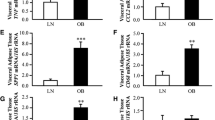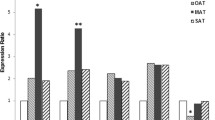Abstract
Lipocalin-2 (LCN2) is a novel adipokine with potential roles in obesity, insulin resistance, and inflammation. The aim of the present work was to evaluate the effect of obesity on circulating concentrations and gene and protein expression levels of LCN2 in human visceral adipose tissue (VAT) as well as its involvement in inflammation. VAT biopsies from 47 subjects were used in the study. Real-time PCR and Western-blot analyses were performed to quantify levels of LCN2 in VAT as well as the association with other genes implicated in inflammatory pathways. Forty-four serum samples were used to analyze the circulating concentrations of LCN2. Zymography analysis was used to determine the activity of matrix metalloproteinase (MMP) in VAT. Obese patients exhibited increased mRNA (p < 0.0001) and protein (p = 0.017) expression levels of LCN2 compared to lean subjects. Although no differences in plasma LCN2 concentrations were observed, increased circulating LCN2/MMP-9 complex levels were found (p = 0.038) in the obese group. Moreover, obese individuals showed increased (p < 0.01) activity of MMP-2 and MMP-9/LCN2 complex, while a positive correlation (p < 0.01) between MMP-2 and MMP-9 activities and BMI was observed. Gene and protein expression levels of LCN2 in VAT were positively associated with inflammatory markers (p < 0.01). These findings represent the first observation that mRNA and protein levels of LCN2 are increased in human VAT of obese subjects. Furthermore, LCN2 is associated with MMP-2 and MMP-9 activities as well as with pro-inflammatory markers suggesting its potential involvement in the low-grade chronic inflammation accompanying obesity.




Similar content being viewed by others
References
Badman MK, Flier JS (2007) The adipocyte as an active participant in energy balance and metabolism. Gastroenterology 132:2103–2115
Frühbeck G, Gómez-Ambrosi J (2001) Rationale for the existence of additional adipostatic hormones. FASEB J 15:1996–2006
Frühbeck G, Gómez-Ambrosi J (2003) Control of body weight: a physiologic and transgenic perspective. Diabetologia 46:143–172
Trayhurn P (2007) Adipocyte biology. Obes Rev 8(Suppl 1):41–44
Van Gaal LF, Mertens IL, De Block CE (2006) Mechanisms linking obesity with cardiovascular disease. Nature 444:875–880
Sethi JK, Vidal-Puig AJ (2007) Targeting fat to prevent diabetes. Cell Metab 5:323–325
Frühbeck G (2008) Overview of adipose tissue and its role in obesity and metabolic disorders. Methods Mol Biol 456:1–22
Flo TH, Smith KD, Sato S, Rodriguez DJ, Holmes MA, Strong RK, Akira S, Aderem A (2004) Lipocalin 2 mediates an innate immune response to bacterial infection by sequestrating iron. Nature 432:917–921
Devireddy LR, Gazin C, Zhu X, Green MR (2005) A cell-surface receptor for lipocalin 24p3 selectively mediates apoptosis and iron uptake. Cell 123:1293–1305
Triebel S, Blaser J, Reinke H, Tschesche H (1992) A 25 kDa α 2-microglobulin-related protein is a component of the 125 kDa form of human gelatinase. FEBS Lett 314:386–388
Liu Q, Nilsen-Hamilton M (1995) Identification of a new acute phase protein. J Biol Chem 270:22565–22570
Wang Y, Lam KS, Kraegen EW, Sweeney G, Zhang J, Tso AW, Chow WS, Wat NM, Xu JY, Hoo RL et al (2007) Lipocalin-2 is an inflammatory marker closely associated with obesity, insulin resistance, and hyperglycemia in humans. Clin Chem 53:34–41
Yan QW, Yang Q, Mody N, Graham TE, Hsu CH, Xu Z, Houstis NE, Kahn BB, Rosen ED (2007) The adipokine lipocalin 2 is regulated by obesity and promotes insulin resistance. Diabetes 56:2533–2540
Zhang J, Wu Y, Zhang Y, Leroith D, Bernlohr DA, Chen X (2008) The role of lipocalin 2 in the regulation of inflammation in adipocytes and macrophages. Mol Endocrinol 22:1416–1426
Tan BK, Adya R, Shan X, Syed F, Lewandowski KC, O'Hare JP, Randeva HS (2009) Ex vivo and in vivo regulation of lipocalin-2, a novel adipokine, by insulin. Diabetes Care 32:129–131
Devireddy LR, Teodoro JG, Richard FA, Green MR (2001) Induction of apoptosis by a secreted lipocalin that is transcriptionally regulated by IL-3 deprivation. Science 293:829–834
Lin Y, Rajala MW, Berger JP, Moller DE, Barzilai N, Scherer PE (2001) Hyperglycemia-induced production of acute phase reactants in adipose tissue. J Biol Chem 276:42077–42083
Aigner F, Maier HT, Schwelberger HG, Wallnofer EA, Amberger A, Obrist P, Berger T, Mak TW, Maglione M, Margreiter R et al (2007) Lipocalin-2 regulates the inflammatory response during ischemia and reperfusion of the transplanted heart. Am J Transplant 7:779–788
Sommer G, Weise S, Kralisch S, Lossner U, Bluher M, Stumvoll M, Fasshauer M (2009) Lipocalin-2 is induced by interleukin-1β in murine adipocytes in vitro. J Cell Biochem 106:103–108
Shoelson SE, Herrero L, Naaz A (2007) Obesity, inflammation, and insulin resistance. Gastroenterology 132:2169–2180
Greenberg AS, Obin MS (2006) Obesity and the role of adipose tissue in inflammation and metabolism. Am J Clin Nutr 83:461S–465S
Stamenkovic I (2003) Extracellular matrix remodeling: the role of matrix metalloproteinases. J Pathol 200:448–464
Bouloumié A, Sengenès C, Portolan G, Galitzky J, Lafontan M (2001) Adipocyte produces matrix metalloproteinases 2 and 9: involvement in adipose differentiation. Diabetes 50:2080–2086
Yan L, Borregaard N, Kjeldsen L, Moses MA (2001) The high molecular weight urinary matrix metalloproteinase (MMP) activity is a complex of gelatinase B/MMP-9 and neutrophil gelatinase-associated lipocalin (NGAL). Modulation of MMP-9 activity by NGAL. J Biol Chem 276:37258–37265
Ginde SR, Geliebter A, Rubiano F, Silva AM, Wang J, Heshka S, Heymsfield SB (2005) Air displacement plethysmography: validation in overweight and obese subjects. Obes Res 13:1232–1237
Catalán V, Gómez-Ambrosi J, Ramírez B, Rotellar F, Pastor C, Silva C, Rodríguez A, Gil MJ, Cienfuegos JA, Frühbeck G (2007) Proinflammatory cytokines in obesity: impact of type 2 diabetes mellitus and gastric bypass. Obes Surg 17:1464–1474
Gómez-Ambrosi J, Catalán V, Diez-Caballero A, Martínez-Cruz LA, Gil MJ, García-Foncillas J, Cienfuegos JA, Salvador J, Mato JM, Frühbeck G (2004) Gene expression profile of omental adipose tissue in human obesity. FASEB J 18:215–217
Catalán V, Gómez-Ambrosi J, Rotellar F, Silva C, Rodríguez A, Salvador J, Gil MJ, Cienfuegos JA, Frühbeck G (2007) Validation of endogenous control genes in human adipose tissue: relevance to obesity and obesity-associated type 2 diabetes mellitus. Horm Metab Res 39:495–500
Catalán V, Gómez-Ambrosi J, Rodríguez A, Silva C, Rotellar F, Gil MJ, Cienfuegos JA, Salvador J, Frühbeck G (2008) Expression of caveolin-1 in human adipose tissue is upregulated in obesity and obesity-associated type 2 diabetes mellitus and related to inflammation. Clin Endocrinol 68:213–219
Rodríguez A, Frühbeck G, Gómez-Ambrosi J, Catalán V, Sáinz N, Diez J, Zalba G, Fortuño A (2006) The inhibitory effect of leptin on angiotensin II-induced vasoconstriction is blunted in spontaneously hypertensive rats. J Hypertens 24:1589–1597
Sier CF, Kubben FJ, Ganesh S, Heerding MM, Griffioen G, Hanemaaijer R, van Krieken JH, Lamers CB, Verspaget HW (1996) Tissue levels of matrix metalloproteinases MMP-2 and MMP-9 are related to the overall survival of patients with gastric carcinoma. Br J Cancer 74:413–417
Frühbeck G, Gómez-Ambrosi J, Muruzábal FJ, Burrell MA (2001) The adipocyte: a model for integration of endocrine and metabolic signaling in energy metabolism regulation. Am J Physiol Endocrinol Metab 280:E827–E847
Fain JN, Buehrer B, Bahouth SW, Tichansky DS, Madan AK (2008) Comparison of messenger RNA distribution for 60 proteins in fat cells vs the nonfat cells of human omental adipose tissue. Metabolism 57:1005–1015
Yang Q, Graham TE, Mody N, Preitner F, Peroni OD, Zabolotny JM, Kotani K, Quadro L, Kahn BB (2005) Serum retinol binding protein 4 contributes to insulin resistance in obesity and type 2 diabetes. Nature 436:356–362
Gómez-Ambrosi J, Rodríguez A, Catalán V, Ramírez B, Silva C, Rotellar F, Gil MJ, Salvador J, Frühbeck G (2008) Serum retinol-binding protein 4 is not increased in obesity or obesity-associated type 2 diabetes mellitus, but is reduced after relevant reductions in body fat following gastric bypass. Clin Endocrinol 69:208–215
Wajchenberg BL, Giannella-Neto D, da Silva ME, Santos RF (2002) Depot-specific hormonal characteristics of subcutaneous and visceral adipose tissue and their relation to the metabolic syndrome. Horm Metab Res 34:616–621
Després JP, Lemieux I (2006) Abdominal obesity and metabolic syndrome. Nature 444:881–887
Montague CT, Prins JB, Sanders L, Zhang J, Sewter CP, Digby J, Byrne CD, O'Rahilly S (1998) Depot-related gene expression in human subcutaneous and omental adipocytes. Diabetes 47:1384–1391
Rodríguez A, Catalán V, Gómez-Ambrosi J, Frühbeck G (2007) Visceral and subcutaneous adiposity: are both potential therapeutic targets for tackling the metabolic syndrome? Curr Pharm Des 13:2169–2175
Hvidberg V, Jacobsen C, Strong RK, Cowland JB, Moestrup SK, Borregaard N (2005) The endocytic receptor megalin binds the iron transporting neutrophil-gelatinase-associated lipocalin with high affinity and mediates its cellular uptake. FEBS Lett 579:773–777
Christiaens V, Scroyen I, Lijnen HR (2008) Role of proteolysis in development of murine adipose tissue. Thromb Haemost 99:290–294
Rangaswami H, Bulbule A, Kundu GC (2006) Osteopontin: role in cell signaling and cancer progression. Trends Cell Biol 16:79–87
Lai CF, Seshadri V, Huang K, Shao JS, Cai J, Vattikuti R, Schumacher A, Loewy AP, Denhardt DT, Rittling SR et al (2006) An osteopontin-NADPH oxidase signaling cascade promotes pro-matrix metalloproteinase 9 activation in aortic mesenchymal cells. Circ Res 98:1479–1489
Philip S, Bulbule A, Kundu GC (2001) Osteopontin stimulates tumor growth and activation of promatrix metalloproteinase-2 through nuclear factor-κ B-mediated induction of membrane type 1 matrix metalloproteinase in murine melanoma cells. J Biol Chem 276:44926–44935
Gómez-Ambrosi J, Catalán V, Ramírez B, Rodríguez A, Colina I, Silva C, Rotellar F, Mugueta C, Gil MJ, Cienfuegos JA et al (2007) Plasma osteopontin levels and expression in adipose tissue are increased in obesity. J Clin Endocrinol Metab 92:3719–3727
Hotamisligil GS, Shargill NS, Spiegelman BM (1993) Adipose expression of tumor necrosis factor-α: direct role in obesity-linked insulin resistance. Science 259:87–91
Mori K, Lee HT, Rapoport D, Drexler IR, Foster K, Yang J, Schmidt-Ott KM, Chen X, Li JY, Weiss S et al (2005) Endocytic delivery of lipocalin-siderophore-iron complex rescues the kidney from ischemia-reperfusion injury. J Clin Invest 115:610–621
Acknowledgements
The authors have nothing to disclose. This work was supported by FIS, PI061458, PI06/90288, and PI081146 from the Spanish Instituto de Salud Carlos III, Ministerio de Sanidad y Consumo, by the Department of Health (20/2005 and 3/2006) and by the Department of Education of the Gobierno de Navarra of Spain. The authors gratefully acknowledge the valuable collaboration of the Department of Surgery and all the members of the Multidisciplinary Obesity Team. We extend a special thanks to Dr. Patricia Fernández-Robredo for her valuable help in determining matrix metalloproteinase activity. CIBER de Fisiopatología de la Obesidad y Nutrición (CIBEROBN) is an initiative of the Instituto de Salud Carlos III, Spain.
Disclosure statement
The authors have nothing to disclose.
Author information
Authors and Affiliations
Corresponding author
Electronic supplementary material
Below is the link to the electronic supplementary material.
Rights and permissions
About this article
Cite this article
Catalán, V., Gómez-Ambrosi, J., Rodríguez, A. et al. Increased adipose tissue expression of lipocalin-2 in obesity is related to inflammation and matrix metalloproteinase-2 and metalloproteinase-9 activities in humans. J Mol Med 87, 803–813 (2009). https://doi.org/10.1007/s00109-009-0486-8
Received:
Revised:
Accepted:
Published:
Issue Date:
DOI: https://doi.org/10.1007/s00109-009-0486-8




